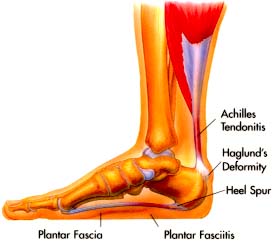Plantar Fasciitis can be a pretty common injury for us long distance folk. I’m sure many of you out there have had it and know that it can be absolutely debilitating. I remember my own bout with the little devil. Every morning I hobbled around like a 90 year old. I remember thinking, this is it; I’m getting old. This is just the start of my body’s long decline into old age. My plantar was so bad I could barely walk for the first hour I was up in the morning. Running was even more painful. I knew if I went out, I’d pay for it later. I started to miss training days. I started to think that I’d never be able to run again. It was rough. 
But, I’m here to tell you that this isn’t where the story ended for me; which means if you’re suffering from plantar as well, you don’t have to give up either. I had plantar for the better part of eight months before I figured out how to get rid of it. Now, by no means is everyone’s case of plantar fasciitis the same, so take what I say with a good deal of those notorious grains of salt. This is a purely subjective article about what helped me. It is by no means meant to be an all inclusive guide to the injury. My hope is that it helps a few of you out there to stop limping and get back out on the road.
So the first thing we need to do is explain that the plantar fascia is a connective tissue that attaches between your heel and your metatarsal bones. It helps to support the arch of your foot. When you start developing plantar fasciitis, essentially this tissue is becoming inflamed because you are subjecting the foot to a high amount stress through weight bearing activity. If you’re overweight, this stress is even greater.
My plantar fasciitis developed because of a few factors. The first was that I wasn’t stretching nearly enough. When we stretch, we are improving flexibility and overall range of motion. This allows our muscles to perform more efficiently and reduces our risk of injury. Now there are some studies that show stretching can be detrimental. But, for the purpose of keeping this article short and because I personally haven’t found anything that helps me feel better after a hard run than stretching, we’ll just let that argument slide (I said subjective article, remember?). Although I did make sure to stretch for five minutes after my runs, I wasn’t doing much to target the muscle groups that were feeding into my plantar. I wasn’t stretching efficiently enough. I also wasn’t really giving myself enough time to stretch; I was rushing through it and it caught up with me. I remedied these issues by first incorporating a great stretch for my calves. If any of you practice yoga, then you are familiar with the downward dog position; it’s a great stretch for your calves and really helps to build flexibility as well. The second thing I did was to be more active in my stretching. Now I take a good ten minutes and make sure to hold each stretch for 20 to 30 seconds, making sure to gradually increase my flex until I feel I can’t go any further.
My other problem that was causing issues with my plantar was my stride itself. I was extremely heavy on my heel which caused me to over-pronate. When you over-pronate, you are placing a great deal of stress on your arch which, as we should all recall now, is supported by the plantar fascia. Even though I did use arch supports, I was still heavy enough on my heel that they weren’t helping to alleviate all of the pressure I was putting on that part of my foot. So, I started to teach myself to run with a more mid-foot stride. What this means is that I was consciously telling myself to strike more towards the balls of my feet as opposed to the heels. I also took shorter strides and focused on propelling myself forward with my arms. I felt like an idiot for the first few weeks. I’m sure I looked fairly uncoordinated. It took three months of having to go out running and actually think about what I was doing. It wasn’t easy. But every time I began to get lazy and start to strike on my heel again, it started to feel my plantar fasciitis act up. As I said, after three months, I could really notice that my form had shifted into an easier, more efficient stride. It was great. I could do my long runs again and not have to worry about limping the rest of the day. I saved the best for last though; I have to say the greatest benefit to teaching myself to run more mid-foot was the speed I picked up. Personally, I am easily 30to 40 seconds faster a mile now than I was with my old stride. I’ve also noticed it’s easier for me to accelerate now and really turn on the jets.
I can’t tell you what a difference both of these have made to my running. For anyone who is struggling with plantar fasciitis, I hope this helped!
If you’re curious about some good stretches check out: http://www.livestrong.com/video/3144-beginners-guide-stretching/
And a great website to look at a mid-foot stride is: http://goodformrunning.com/
